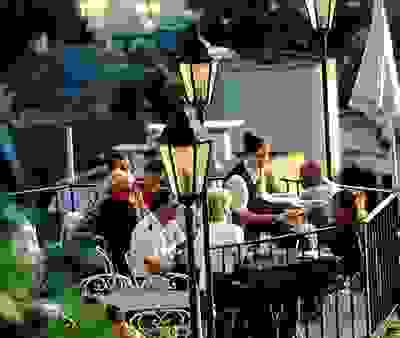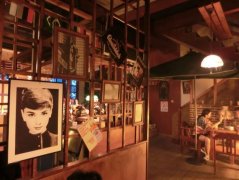Hungary, which is soaked in coffee, integrates coffee into its own life.
Hungary is not only a hot spring country, but also a coffee kingdom. Hungarians are famous for their love of cafes. They can skip drinking and smoking without drinking coffee for a day. Today, there are still countless cafes with "Pleso" signs in the streets, and even many bigwigs in business and politics take the time to make a cup of coffee every day. Budapest people have already incorporated coffee into their lives.
Cafes have a long history in Budapest and have been one of the most attractive features of this beautiful city since the time of the Austro-Hungarian Empire. Budapest was known as the "city of five hundred cafes" at the end of the 19th century. The caffeine is also a gathering place for Hungarian literati. At that time, many Hungarian writers would come to the fixed cafe every day. At that time, the address on the writers' business cards was used not to write their own place, but the name of their favorite cafe. This is like his second home. If people want to talk to them, they can come to the cafe.
The city can enjoy more sunshine than most European cities, and on sunny afternoons, under the umbrella of every open-air coffee bar, there are people of different ages, different skin colors, but with the same cozy expressions. Sit in a cafe, order a cup of coffee, or read a book or newspaper, or chat with friends, or be in a daze-unwittingly escape into that brilliant and distant old dream.

How about Hungary? the cafe is the epitome of Budapest.
The New York Cafe is known as the "most beautiful cafe in the world." as early as World War I, it was already the cultural center of Budapest. At that time, many magazines and publishers in Europe set up offices in the building where the cafe was located. At that time, the editorial office of the most influential magazine, the West, was located here, so many famous writers and poets were regular visitors to the New York Cafe.
This is a coffee palace that is more beautiful than any one can imagine. Everywhere is resplendent, elegant and elegant. Decorated with gold paint relief, painted murals and crystal lamps, smallpox is simply the imperial court of the palace. The only difference from the palace is that what is hung on the walls around here are not portraits of kings, but portraits of more than a dozen writers at that time. The cafe, which opened in 1894, was popular not only for free coffee to poor writers, but also for paper, pen and ink. Another writer is said to have thrown the key to the cafe into the river in an attempt to make it open 24 hours a day. By the beginning of the 20th century, cafes had become a place for intellectuals, and MichaelCurtis, director of North African spy film, and AlexanderKorda, director of Thief of Baghdad, were guests.
After the changes of the times, the New York Cafe has restored its original appearance. The shop's authentic old furniture and colorful works of art make people feel like a tumble back to Hungary 150 years ago, and many Hungarian "upper echelons" are hardcore FANS here. In fact, a small coffee shop is like a microcosm of Budapest. Sparkling Danube, jingling old streetcars, old castles and churches. It all implies that this is a city suitable for nostalgia and romance, and Hungarians savor history and life under the eaves of crystal chandeliers in the strong aroma of coffee.
How about Hungary? its elegance captivates Madonna.
Another of Budapest's most famous cafes is Gerbeaud, which opened in 1858. It is said that it was the favorite of Queen Elizabeth of Austria-Hungary more than a hundred years ago. A century and a half later, the rococo ceiling, satin curtains, bluestone tables and mahogany seats of the cafe still exude the elegance of the old world; each hall of the cafe has its own tone, from light beige to aristocratic red, from rose purple to deep palace satin green and gold, and the halls are separated by low-hanging velvet curtains, luxurious and deep, filled with a changing stage atmosphere. No wonder big stars like Madonna and Antonio Bandalas can't help coming to feel the atmosphere of more than a hundred years ago.
How about Hungary, an old European gentleman?
CentralK á v é h á z, which has been in business since 1887, has an antique flavor. The history of more than 100 years is really her proud capital. Typical European architecture, large floor-to-ceiling windows, you can see an elegant lady in a dress and a wide-brimmed hat sipping coffee in a cup, and an old gentleman in a dark tweed suit flipping through his newspaper. Young people may not get used to the festival here, this is definitely a place that reflects the old European flavor. In the eyes of local residents, this is the core area of Budapest cafe culture.
In 1913, Centro á LK á v é h á z was renovated and rebuilt. The cafe survived the destruction of the second World War and has been preserved intact to this day. Since 2000, the coffee shop that has been renovated has resumed business. The cafe also serves all kinds of traditional Hungarian delicacies, ordering a cup of coffee, or eating here, you can feel more deeply the sound of coffee rubbing against the tip of your nose, the tip of your pen rubbing against paper, and the sound of thoughts colliding.
Hungary is the capital of music, the home of hot springs and the kingdom of coffee. This country can bring you so much that when you stop and look back after all this, you will find that you have been fascinated by it.
Important Notice :
前街咖啡 FrontStreet Coffee has moved to new addredd:
FrontStreet Coffee Address: 315,Donghua East Road,GuangZhou
Tel:020 38364473
- Prev

The Story of the Caf é in the Cafe
Gu Yue was 22 years old and was a handsome little boy in Chongqing Vector Cafe. In his world, everything is new and unknown. In the summer of 2008, he met Marie. She is over 60, dressed in a suit, slightly fat, but elegant. She looks very kind, especially when she purses her lips like a lovely child. Gu Yue remembers her with silent eyes.
- Next

Coffee life gives people a leisurely taste of life.
Some people think that drinking coffee can prevent fatigue and relieve difficulties, but more people like the comfortable and quiet feeling of life given by coffee. Coffee was originally a drink that Westerners must drink every day, but with the development of the times and the increasing degree of China's opening to the outside world, coffee has not only become a favorite drink for Westerners, but also gradually accepted by the majority of Chinese consumers. Someone
Related
- How did the Salvadoran coffee industry develop in Central America?
- What exactly does the golden cup extraction of coffee mean?
- The Origin of Coffee flower
- [2023 Starbucks World Earth Day] there are more meaningful things besides free Starbucks coffee!
- What kind of coffee is there in Spain? 9 Flavors of Spanish Coffee
- Aromatic African coffee| Kenya's coffee culture and historical production area
- Liberica Coffee Bean knowledge: the characteristics of Liberian Coffee beans of the three original species of Coffee beans
- The origin and formula of Spanish latte introduces the taste characteristics of Bombon coffee in Valencia, Spain.
- How to adjust the solution of over-extracted coffee
- What is the tasting period of coffee beans? What is the period of coffee and beans? How should coffee wake up and raise beans?

